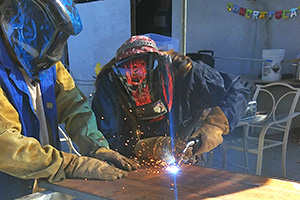
Dulce Benavides and her father (Photos courtesy of Dulce Benavides)
When Dulce Benavides took her first welding class at San Bernardino Valley College, she was afraid because she was the only female in the class. But her father, a welder himself, had prepared her with the basics and, more importantly, gave her words to remember that she carries with her every day. In Spanish, he told her, “No, I don’t know how to do it, but if you show me, I will learn.”
Welding was not Benavides’ first choice after high school. She wanted to study mortuary science in another state, but health concerns kept her closer to home and looking for a different field of study. She decided to enroll at SBVC for general education classes and tried a welding class because of her father. Out of 20 students, she was the only woman and the men did not expect her to continue.
“After the third week, they were like, ‘You’re still here. What are you doing here?’”, recalled Benavides. By the end of the class, around 10 male students had dropped out and Benavides completed the course.
According to the U.S. Bureau of Labor Statistics, fewer than five percent of the nation’s welders are women. It’s a field that requires a skilled-labor workforce and provides a good middle-class income. A starting apprentice with no experience can earn $24 an hour and good benefits.
“Women don’t go into welding because they’re scared,” said Benavides. “When you think about welding, you see all these sparks and pretty much men doing it. I think it discourages women because when you look at it, it looks like a man’s field.” She also cites getting burned by the sparks as another a reason men and women may drop from the welding program.
SBVC Welding Instructor Dan Comiskey agreed with the prevailing image of welding. “I think there’s probably a long-standing ‘it’s a men’s trade’ type of thing. So they may not be attracted to it as much. But companies love to hire women. They get to check off a lot of boxes. There is a lot of opportunity with them.”
 The opportunity is there for companies because, according to both Benavides and Comiskey, women are better welders. “Generally women do make better welders than men,” said Comiskey. “Could be their patience, their attention to detail. I don’t know what it is. Generally if I have a girl in my class, they’re usually in the top five, if not the best welder.”
The opportunity is there for companies because, according to both Benavides and Comiskey, women are better welders. “Generally women do make better welders than men,” said Comiskey. “Could be their patience, their attention to detail. I don’t know what it is. Generally if I have a girl in my class, they’re usually in the top five, if not the best welder.”
Benavides added, “Women generally have better hand-eye coordination. We pay more attention to detail. So if you draw a line on paper, men will just draw a line and women will try to make it as perfect as they can. So that’s the difference between and man and a woman in welding. It’s kind of intimidating for men because it’s kind of a thing they don’t see all the time and they can’t hide the fact that we do it better than they do.”
She should know as she won a first place medal during a recent regional SkillsUSA welding competition, then going on to win second place in the statewide event and beating out many men including a 20-year welding veteran. She is also president of the SBVC Welding Club and works hard to encourage more women to study welding.
The opportunity for students is that welders are in demand. “An instructor for the apprenticeship program came to the school and he needs 500 welders tomorrow,” Comiskey recalled. “The boilermakers’ union needs 1,000 welders. This is just in Southern California.”
SBVC Welding Technology is among many community college departments working on filling the growing demand for skilled workers in every region. Students can earn their Associate’s degree in General Welding and/or earn a welding certificate at SBVC. The department works with an advisory board that includes local unions and manufacturers so it can offer the training needed for employment. It has also upgraded its facilities to include state-of-the-art labs and equipment.
California's community college system has crafted a workforce development revival within the Strong Workforce Program which is encouraging coordination and collaboration among the 113 colleges. At the 2017 California Economic Summit happening in November in San Diego (Registration and Information), strategies to continue this workforce renewal will take shape, plus leaders from all three of the state's higher education systems will be featured.
For Benavides, she is looking to graduate in 2018, find work in welding, then return to school and become a welding instructor. She will take her father’s advice full circle by not only learning, but teaching others, including more women.

